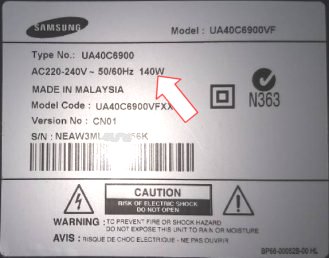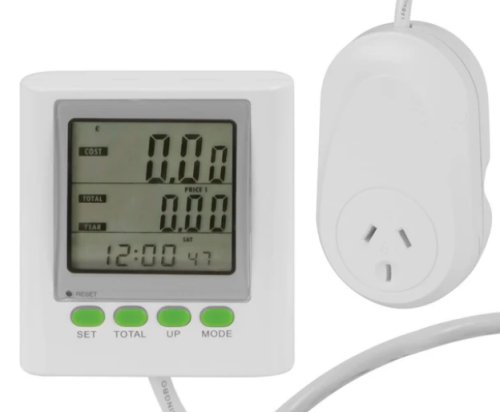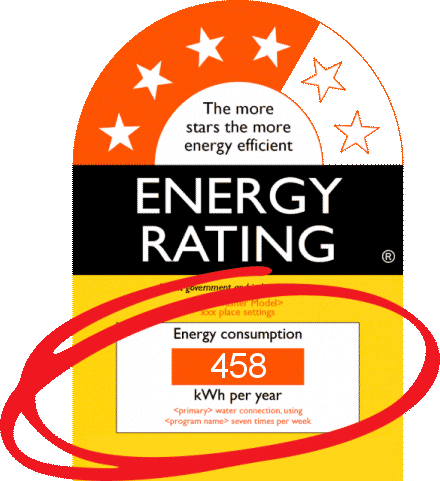Home Appliances: Assessing Energy Efficiency and Saving Smarter
Last Updated: 9th Jan 2025 By Finn Peacock, Chartered Electrical Engineer
In this article, we begin by discussing all things measurement. Remember that a kilowatt-hour, or kWh, was once called a “unit of electricity” on ancient electricity bills. It is a measure of energy.
For example, if you run a 1,500W bathroom heater (its measure of power) for one hour, you have used:
1,500 Watts x 1h = 1,500 Watt-hours – which is shortened for convenience to 1.5kWh energy (that probably cost you over 50c).
So, for talking about appliance energy use, the kWh nomenclature reigns supreme.
Afterwards, we will list some tips that you can apply in your daily life to reduce the energy use of your appliances.
Common Trap Of Checking Power Usage
Just what do your appliances use? Here is a way of looking at it – not necessarily good.
Don’t fall into the trap of only reading the manufacturer compliance plate at the rear of most appliances!

Here is an old back-lit LCD TV of mine. You’d think we could just take the ‘140W’ power rating and multiply it by the hours of use. This would give, for example:
140W x 3 hours = 420 Wh or 0.42 kWh
On that basis, you could say you would easily use half a kWh for a few hours’ use of an evening – but I know this is wrong! I have actually measured the usage of this TV, and it is about 70W or so typically.
These manufacturer appliance labels show the maximum possible draw of the appliance. This has to do with the safety angle; for example, of not using undersized house cabling. Appliance labels help the householder, and any electrician, determine maximum current demand on the cabling.
Measure Your Own Appliances
An answer here is to measure your own appliances. Here’s how I measured my TV – I used a plug-in power consumption meter. While this isn’t the one I used, here’s what they can look like:
Usage: I plug the meter into the TV’s power-point, plug the TV into it, then set the time period to measure; say 24 hours. If that 24-hour period is typical of the TV’s usage pattern, then I have a good idea of what energy I use per day.
These plug-in meters can be found online and in some electrical stores. Typically, they cost about $30 including postage.
Some things to make sure the meter does:
- Must measure kWh
- Should have a settable time period
- Should be at least 10A current rating
- Australian-pattern 3-pin plug and socket
- A user manual – might be handy!
Energy Rating Labels
As you likely would have seen, there are energy rating labels on many appliances – these are commonly referred to as ‘energy-rating stars’. The benefit of this national labelling scheme is that the measurement of average consumption is already done!
These labels are required on appliances sold in Australia such as:
- Non-ducted household air conditioners
- Clothes dryers
- Washing machines
- Computer monitors
- Dishwashers
- Household refrigerators and freezers
- Pool pumps
- Televisions
What Do Energy Rating Labels Indicate?
The number of stars is a rough indication of how little (or much) power any appliance uses. The more stars (up to a maximum of 6), the less energy it should use.
The secondary listing of “kWh per year” is very useful for comparison. It allows you to accurately compare your energy usage in terms of kWh per day – provided you divide the annual kWh usage by 365. For example, a fridge that uses 365kWh per year will use on average 1kWh per day.
The Energy Rating Calculator allows you to quickly find star ratings and running costs for common household appliances.
For example, if you want to buy a new fridge, 350 to 400 litres:
- Click on the Fridges and Freezers icon.
- Move the capacity slider to span from 350 to 405 litres.
- Click the “apply filter” button.
You’ll see running costs ranging from $60 to $120 per year, and up to $263 per year for less efficient models. You can also compare other appliances in a similar manner.
Household Appliance Energy Efficiency Tips
Even if you have energy-efficient appliances, how you use them will dictate how much you save and spend on running them (and their lifespan). Here are some tips to minimise electricity consumption and maximise service life.
Cooking
- Select the best tool for the job – for example, a microwave will use less electricity than a conventional oven.
- When using a stovetop, use lids on pots to retain heat, and the most appropriately sized burner or element.
- When boiling a kettle, only add as much water as you need – water heating is energy intensive!
- If using a conventional oven, make sure the door seal is clean. And that goes for the oven window too – the less you have to open the oven while cooking to check on your food, the better.
- If preheating an electric oven (which doesn’t have to be done with gas), ensure you stick the food in as soon as the oven has reached the desired temperature.
- Thaw foods before cooking. While leaving them out on a bench is the most popular way, be careful you don’t leave them out too long. You can also thaw in the fridge. While this will take much longer, it’s a good food safety move.
Dishwashers
- If you’re on a Time of Use (ToU) electricity plan, set your dishwasher’s timer for the period of the day when electricity is cheapest. If you have solar panels, run it during periods of sunshine.
- Only wash full loads, and on the most economical setting unless there is heavy grime.
- Clean the filter regularly.
Fridges And Freezers
- For the most economical and food-safe temperatures, set your fridge to between 3°C and 4°C and freezer to between minus 15°C and minus 18°C.
- Positioning is important – these appliances should be kept out of direct sunlight and there should be a gap around them to promote airflow.
- Keep the doors closed as much as possible; upright freezers and fridges in particular. Once the door is open, cold air “falls out” as it is heavier than warm air.
- Make sure external vents are kept free of dust buildup.
- Ensure door seals are clean and even.
- Do you really need that beer fridge out in the garage running 24/7/365? It could be burning a hole in your wallet. If you do decide to turn off such a fridge when not in use, be sure to keep the door slightly ajar so that mould doesn’t grow within.
Washing Machines And Dryers
- If you have a solar power system, consider running these appliances during sunshine hours.
- Unless clothes are heavily soiled, washing in cold water on the economy cycle will save some dollars.
- Avoid less than full loads, but also don’t overfill. (Note: some washing machines will automatically sense the size of the load and adjust water levels accordingly).
- Line dry instead of using a clothes dryer, where possible.
- Ensure as much water as possible has been spun out of clothes before placing them in the dryer.
- A dryer in a humid room will struggle, so ensure good ventilation in your laundry.
- A clothes dryer’s lint filter should be inspected and cleaned regularly. This isn’t just about efficiency, but also safety (lint buildup can cause fires).
Pool Pumps
- Use a timer so the pump runs at the most appropriate (cheapest) time of the day – for example, during daylight hours if you have a solar power system.
- Reduce pumping time to the bare minimum (consult the pool and pump manufacturer).
- Run the pump at the lowest recommended speed.
- Using a pool cover can keep a significant amount of detritus out of your pool, meaning less pumping.
- A variable-speed pump uses less than half the energy compared to older, single-speed models.
Whether you have solar panels or not, these tips can help you save. But if you’re part of the latter group, consider installing a solar power system to achieve tiny bills. Find out how much you could save with solar – it’s quick and easy to do!

